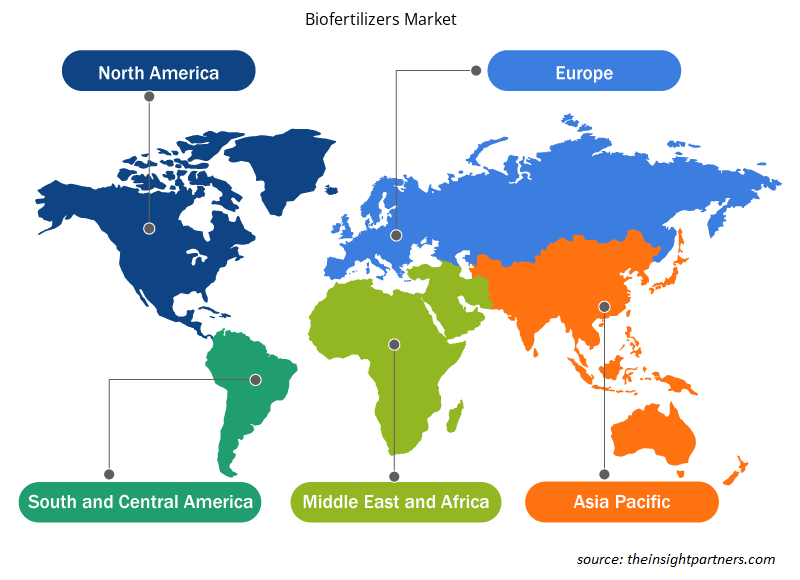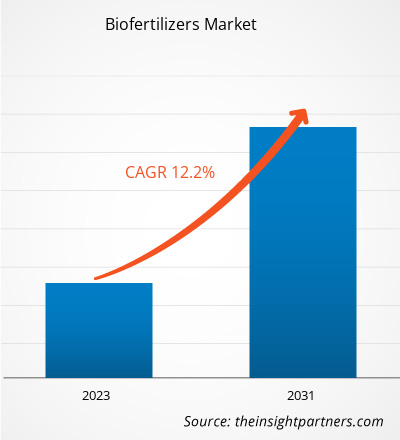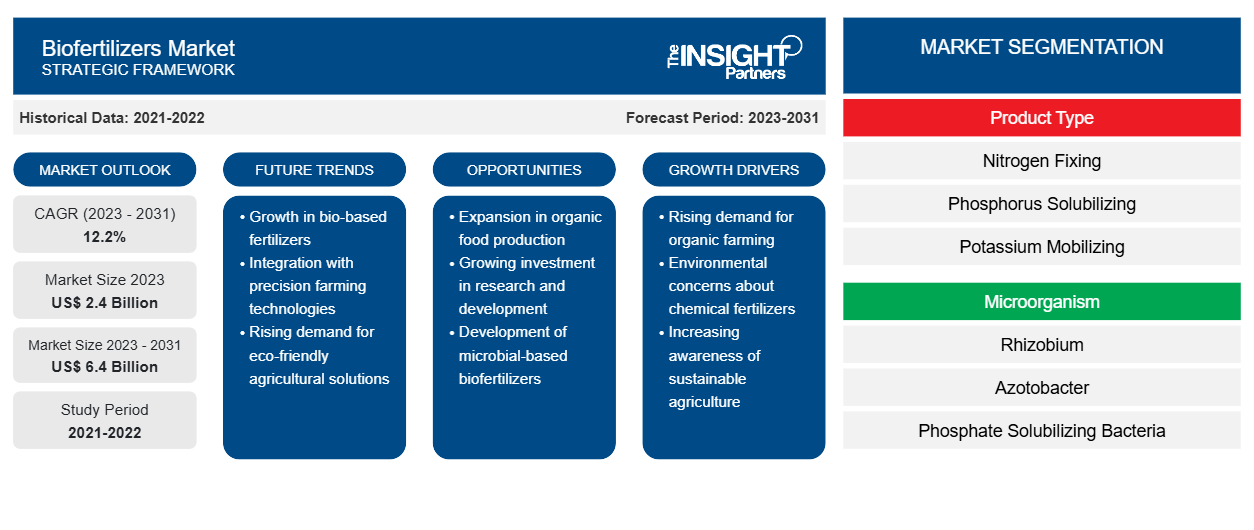Le marché des biofertilisants devrait atteindre 6,4 milliards de dollars d'ici 2031, contre 2,4 milliards de dollars en 2023. Le marché devrait enregistrer un TCAC de 12,2 % au cours de la période 2023-2031. L'accent croissant mis par les entreprises manufacturières sur l'innovation et la fourniture de nouveaux produits pour améliorer l'expérience client devrait rester une tendance clé sur le marché des biofertilisants.
Analyse du marché des biofertilisants
La méthode d'agriculture biologique comprend la croissance et l'entretien des cultures avec l'utilisation de matières biologiques en éliminant l'utilisation d'engrais synthétiques. L'agriculture biologique est de plus en plus adoptée pour obtenir des produits alimentaires sains et de haute qualité . Parallèlement à cela, l'agriculture biologique offre plusieurs avantages environnementaux ; par exemple, elle améliore la fertilité des sols, aide à lutter contre l'érosion des sols et réduit les émissions de gaz à effet de serre. Les biofertilisants sont l'un des composants essentiels des pratiques d'agriculture biologique car ils combinent des micro-organismes naturels avec des engrais riches en nutriments d'origine organique qui offrent un environnement de croissance sain aux plantes et aux sols. Les biofertilisants aident également à améliorer la résistance de la plante aux parasites et aux facteurs de stress abiotiques tels que la sécheresse, l'excès d'eau et les changements extrêmes de température. Ainsi, la croissance rapide de l'agriculture biologique due à l'adoption accrue de produits biologiques par les consommateurs du monde entier stimule la croissance du marché des biofertilisants.
Aperçu du marché des biofertilisants
Les biofertilisants sont constitués de microbes et de bactéries vivantes qui favorisent la fertilité du sol et la croissance des plantes. Ces microbes soutiennent le processus de fixation de l'azote pour produire les composants essentiels à la croissance de la plante. Les biofertilisants sont bien connus pour leur rentabilité et leur nature respectueuse de l'environnement. Le marché des biofertilisants connaît une forte demande en raison d'un changement de tendance vers une agriculture durable . L'intérêt croissant et le soutien du gouvernement pour l'agriculture biologique ont entraîné un boom dans l'industrie des biofertilisants. Ainsi, le marché des biofertilisants devrait renforcer sa croissance au cours de la période de prévision.
Personnalisez ce rapport en fonction de vos besoins
Vous bénéficierez d'une personnalisation gratuite de n'importe quel rapport, y compris de certaines parties de ce rapport, d'une analyse au niveau des pays, d'un pack de données Excel, ainsi que de superbes offres et réductions pour les start-ups et les universités.
-
Obtenez les principales tendances clés du marché de ce rapport.Cet échantillon GRATUIT comprendra une analyse de données, allant des tendances du marché aux estimations et prévisions.
Facteurs moteurs et opportunités du marché des biofertilisants
Initiatives gouvernementales croissantes et sensibilisation accrue aux techniques d'agriculture durable
Les gouvernements de divers pays prennent des initiatives pour favoriser l’adoption des biofertilisants. Par exemple, en Inde, plusieurs gouvernements d’États ont soutenu l’utilisation de biofertilisants par rapport aux engrais chimiques ou synthétiques par le biais de programmes ou de dispositifs tels que « Paramparagat Krishi Vikas Yojana (PKVY) » et « Mission Organic Value Chain Development for Northeastern Region (MOVCDNER) ». En outre, la « Politique agricole commune » de l’Union européenne (UE) vise à promouvoir l’utilisation des ressources biologiques dans toute la région. Ainsi, les initiatives gouvernementales, ainsi que la tendance croissante à la durabilité dans l’agriculture moderne, déclenchent la demande de biofertilisants dans le monde entier.biofertilizers. For instance, in India, various state governments have been supporting the use of biofertilizers over chemical or synthetic fertilizers through programs or schemes such as “Paramparagat Krishi Vikas Yojana (PKVY)” and “Mission Organic Value Chain Development for Northeastern Region (MOVCDNER).” Further, the “Common Agricultural Policy” by the European Union (EU) aims to promote the use of biological resources across the region. Thus, government initiatives, along with the increased inclination toward sustainability in modern agriculture, trigger the demand for biofertilizers across the world.
Augmentation de la production et du rendement des cultures
L'application de biofertilisants est l'une des technologies potentielles pour des systèmes agricoles durables. Les agriculteurs utilisent largement des biofertilisants fixateurs d'azote solubilisant le phosphate pour produire des cultures à forte demande telles que le blé, les oléagineux et le riz. Ainsi, différents micro-organismes sont inclus dans les biofertilisants pour aider à augmenter la production et le rendement des cultures, offrant ainsi diverses opportunités de croissance pour le marché des biofertilisants à travers le monde.biofertilizers is one of the potential technologies for sustainable farming systems. Famers are widely using nitrogen-fixing phosphate solubilizing bio-fertilizers to produce high-demand crops such as wheat, oilseeds, and rice. Thus, different microorganisms are included in biofertilizers to help increase the production and yield of crops, thereby providing various growth opportunities for the biofertilizers market across the world.
Analyse de segmentation du rapport sur le marché des biofertilisants Market Report Segmentation Analysis
Les segments clés qui ont contribué à l’élaboration de l’analyse du marché des biofertilisants sont le type de produit, le micro-organisme, le type de culture et l’application.Biofertilizers Market analysis are product type, microorganism, crop type, and application.
- En fonction du type de produit, le marché des biofertilisants est divisé en fixation de l'azote, solubilisation du phosphore, mobilisation du potassium et autres. Le segment de fixation de l'azote détenait la plus grande part de marché en 2023.biofertilizers market is divided into nitrogen fixing, phosphorus solubilizing, potassium mobilizing, and others. The nitrogen fixing segment held the largest market share in 2023.
- En termes de micro-organismes, le marché est segmenté en rhizobium, azotobacter, bactéries solubilisant le phosphate et autres. Le segment du rhizobium détenait la plus grande part du marché en 2023.rhizobium, azotobacter, phosphate solubilizing bacteria, and others. The rhizobium segment held the largest share of the market in 2023.
- En termes de type de culture, le marché est divisé en céréales et grains, graines oléagineuses et légumineuses, fruits et légumes, etc. Le segment des céréales et des grains a dominé le marché en 2023.
- En fonction de l'application, le marché est divisé en traitement des semences, traitement des sols et autres. Le segment du traitement des semences a dominé le marché en 2023.
Analyse des parts de marché des biofertilisants par zone géographique
La portée géographique du rapport sur le marché des biofertilisants est principalement divisée en cinq régions : Amérique du Nord, Asie-Pacifique, Europe, Moyen-Orient et Afrique, et Amérique du Sud/Amérique du Sud et centrale.
L'Amérique du Nord domine le marché des biofertilisants. L'Amérique du Nord est l'une des régions les plus importantes pour ce marché en raison de la consommation croissante d'aliments biologiques et sans produits chimiques dans la région. De plus, les États-Unis comptent parmi les principaux producteurs de biofertilisants dans le monde. Bien que les engrais chimiques ne soient généralement pas étiquetés « sains », les consommateurs recherchent des alternatives plus saines telles que les biofertilisants. L'un des moteurs du marché, selon le DOE et l'USDA, est l'abondance de matières premières issues de la biomasse. Ce sont là quelques-uns des facteurs qui stimulent la demande de biofertilisants dans les pays d'Amérique du Nord. L'Asie-Pacifique devrait connaître le TCAC le plus élevé dans les années à venir.
Aperçu régional du marché des biofertilisants
Les tendances régionales et les facteurs influençant le marché des biofertilisants tout au long de la période de prévision ont été expliqués en détail par les analystes d’Insight Partners. Cette section traite également des segments et de la géographie du marché des biofertilisants en Amérique du Nord, en Europe, en Asie-Pacifique, au Moyen-Orient et en Afrique, ainsi qu’en Amérique du Sud et en Amérique centrale.

- Obtenez les données régionales spécifiques au marché des biofertilisants
Portée du rapport sur le marché des biofertilisants
| Attribut de rapport | Détails |
|---|---|
| Taille du marché en 2023 | 2,4 milliards de dollars américains |
| Taille du marché d'ici 2031 | 6,4 milliards de dollars américains |
| Taux de croissance annuel composé mondial (2023-2031) | 12,2% |
| Données historiques | 2021-2022 |
| Période de prévision | 2023-2031 |
| Segments couverts |
Par type de produit
|
| Régions et pays couverts |
Amérique du Nord
|
| Leaders du marché et profils d'entreprises clés |
|
Densité des acteurs du marché : comprendre son impact sur la dynamique des entreprises
Le marché des biofertilisants connaît une croissance rapide, tirée par la demande croissante des utilisateurs finaux en raison de facteurs tels que l'évolution des préférences des consommateurs, les avancées technologiques et une plus grande sensibilisation aux avantages du produit. À mesure que la demande augmente, les entreprises élargissent leurs offres, innovent pour répondre aux besoins des consommateurs et capitalisent sur les tendances émergentes, ce qui alimente davantage la croissance du marché.
La densité des acteurs du marché fait référence à la répartition des entreprises ou des sociétés opérant sur un marché ou un secteur particulier. Elle indique le nombre de concurrents (acteurs du marché) présents sur un marché donné par rapport à sa taille ou à sa valeur marchande totale.
Les principales entreprises opérant sur le marché des biofertilisants sont :
- AgriLife
- Biotech International Ltée.
- Société du groupe de produits biotechnologiques Kiwa
- Mapleton Agri Biotec Pt Ltd.
- Novozymes
- RIZOBACTER
Avis de non-responsabilité : les sociétés répertoriées ci-dessus ne sont pas classées dans un ordre particulier.

- Obtenez un aperçu des principaux acteurs du marché des biofertilisants
Actualités et développements récents du marché des biofertilisants
Le marché des biofertilisants est évalué en collectant des données qualitatives et quantitatives issues de recherches primaires et secondaires, qui comprennent d'importantes publications d'entreprises, des données d'associations et des bases de données. Voici une liste des évolutions du marché des troubles de la parole et du langage :
- Syngenta Biologicals et Unium Bioscience annoncent une collaboration visant à proposer aux agriculteurs du nord-ouest de l'Europe des solutions de traitement biologique des semences innovantes basées sur NUELLO® iN. (Source : Syngenta, Newsletter, 2023)
- Performance Nutrition a lancé sa marque NutriWise, un engrais granulaire et une poudre hydrosoluble qui remplacera l'ancienne gamme de produits NutriSmart. Les nouveaux produits sont disponibles pour les marchés agricoles, du gazon et des plantes ornementales. (Source : LidoChem, Inc., Communiqué de presse, 2022)
Rapport sur le marché des biofertilisants : couverture et livrables
Le rapport « Taille et prévisions du marché des biofertilisants (2021-2031) » fournit une analyse détaillée du marché couvrant les domaines ci-dessous :
- Taille du marché et prévisions aux niveaux mondial, régional et national pour tous les segments de marché clés couverts par le périmètre
- Dynamique du marché, comme les facteurs moteurs, les contraintes et les opportunités clés
- Principales tendances futures
- Analyse détaillée des cinq forces de PEST/Porter et SWOT
- Analyse du marché mondial et régional couvrant les principales tendances du marché, les principaux acteurs, les réglementations et les développements récents du marché
- Analyse du paysage industriel et de la concurrence couvrant la concentration du marché, l'analyse de la carte thermique, les principaux acteurs et les développements récents
- Profils d'entreprise détaillés
- Analyse historique (2 ans), année de base, prévision (7 ans) avec TCAC
- Analyse PEST et SWOT
- Taille du marché Valeur / Volume - Mondial, Régional, Pays
- Industrie et paysage concurrentiel
- Ensemble de données Excel
Rapports récents
Rapports connexes
Témoignages
Raison d'acheter
- Prise de décision éclairée
- Compréhension de la dynamique du marché
- Analyse concurrentielle
- Connaissances clients
- Prévisions de marché
- Atténuation des risques
- Planification stratégique
- Justification des investissements
- Identification des marchés émergents
- Amélioration des stratégies marketing
- Amélioration de l'efficacité opérationnelle
- Alignement sur les tendances réglementaires























 Obtenez un échantillon gratuit pour - Marché des biofertilisants
Obtenez un échantillon gratuit pour - Marché des biofertilisants